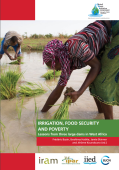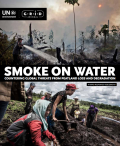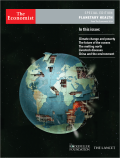
This report presents field evidence from three major public financing schemes for large-scale rice irrigation in West Africa. The report assesses the cost-effectiveness of the schemes, the quality of their management, and the persistence of poverty and food insecurity. It shows that answering questions including, “what type of farmers get the best results?”, “how big should plot sizes be and with what tenure conditions?” and “what credit and marketing systems would support farmers effectively?” are needed if production is to be sustainably improved.
The report aims to help decision makers understand project outcomes and optimize the returns on State investment, both for the taxpayer and for individual farmers. It makes recommendations for action and for the better alignment of public policy objectives with the interests of a diverse set of smallholder farmers, from making better use of existing systems to improving the design of future projects.

Smoke on Water – Countering Global Threats From Peatland Loss and Degradation is a Rapid Response Assessment that looks at peatland location, extent, threats and the policies to manage and protect them. The goal of this rapid response assessment, carried out on behalf of UN Environment and based on the efforts of more than 30 contributors, is to raise awareness about the importance of the world's peatlands and to encourage immediate action to preserve them.
The assessment supports the Global Peatlands Initiative and is based on existing data and information. Its main messages are:
1. Peatlands are important to human societies around the world. They contribute signicantly to climate change mitigation and adaptation through carbon sequestration and storage, biodiversity conservation, water regime and quality regulation, and the provision of other ecosystem services that support livelihoods.
2. Immediate action is required to prevent further peatland degradation and the serious environmental, economic and social repercussions it entails.

What risks do our civilisations face, and how will we identify them? Are we living through a key transition for our species and civilisations, and how would we know if we were? What forces have shaped past civilisations and our civilisations today, and what will protect future civilisations? What will determine human sustainability and resilience in the face of these planetary dangers? Is human and planetary sustainability compatible with our current expectations for economic growth and material prosperity?
To answer these and other questions, The Lancet and The Rockefeller Foundation are launching a commission and convening a major global gathering at the Foundation’s Center in Bellagio, Italy. This special edition of The Economist magazine will, together with other inputs, help shape that ongoing conversation.
Sea-level rise threatens low-lying areas around the world’s coasts with increased coastal flooding during extreme sea level events during storms. One response to this challenge is to build or upgrade coastal flood defences as exemplified by the Netherlands, New Orleans or much of the Chinese coast. In this paper the authors examine the potential investment costs of such an adaptation strategy applied globally over the 21st Century for sea-level rise scenarios consistent with the RCP2.6 and RCP8.5 emissions and the SSP2 socio-economic scenarios. Results are reported at the scale of World Bank Regions and the globe. This considers several contrasting scenarios of protection strategies as defined below. The DIVA model framework for coastal analysis is used to perform the analysis.

Effective flood risk management is critical to protect people and their livelihoods from flooding and to limit future losses. Nature-based measures and their ability to address flood risk are receiving increasing attention. Until recently, most flood risk management involved conventional engineering measures. These measures are sometimes referred to as “hard” engineering or “gray” infrastructure. Examples include building embankments, dams, levees, and channels to control flooding. Recently the concept of “nature-based solutions”, “ecosystem-base adaptation”, “eco-DRR” or “green infrastructure” has emerged as a good alternative or complement to traditional gray approaches. Nature-based solutions make use of natural processes and ecosystem services for functional purposes, such as decreasing flood risk or improving water quality. The objective of this document is to present five principles and implementation guidance for planning, such as evaluation, design, and implementation of nature-based solutions for flood risk management as an alternative to or complementary to conventional engineering measures.
